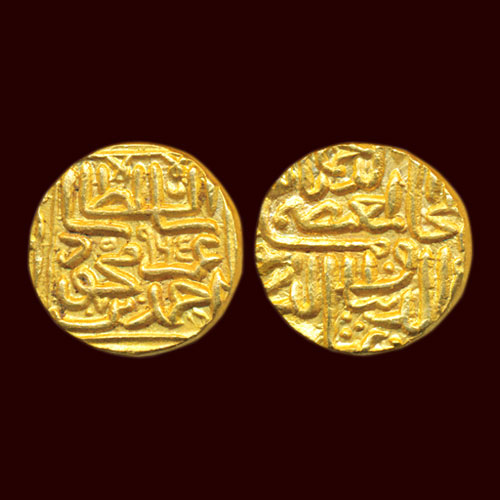Gujarat Sultanate Ahmad Shah III’s Gold Tanka
2018-12-14 Fri
The Sultanate of Gujarat was a late medieval kingdom established during the early 15th Century. It was established by Zafar Khan (son of Sadharan, a Tanka Rajput) in the year 1396. He was appointed as a Governor of Gujarat by Nasir-ud-din Muhammad Bin Tughluq IV in the year 1391 AD.Ghiyath ud Din Ahmed Shah III was born as Ahmad Khan. He was the Sultan of Muzaffarid dynasty who ruled over the Gujarat Sultanate, in the late medieval period during 1553 CE till 1560 CE. The Muzaffarid dynasty refers to the people who had ruled Gujarat between 1391 CE to 1583 CE. They were also referred to as Ahmadabad Dynasty. The founder of this dynasty was Zafar Khan; who was the governor of Gujarat under Delhi Sultanate.
This rare gold tanka was issued by Ghiyath ud din Ahmed Shah III during the Hijri year 965. The weight of this coin is around 11.9g. The obverse of this coin is inscribed as ‘Al-Mutasim Billah Al-Rahman Ghiyath Al-Dunya Wa Al-Din Abul Muhamid’. The reverse of the coin is inscribed as ‘Ahmad Shah Bin Mahmud Shah Al-Sultan Umr’. This rare gold mohur is listed for INR 55,000 in the upcoming auction of Todywalla which will be held in Pune on 16th December 2018.
Image Courtesy: Todywalla Auction
Latest News
-
Malwa Sultan Mahmud Shah Silver Coins
2025-09-11 ThuMalwa Sultan Mahmud Shah minted silver coins in round and square flans. <br><br> For round coins,...
-
Malwa Sultan Mahmud Shah Billon coin
2025-08-26 TueMalwa Sultan Mahmud Shah's billon coins followed three weight standards: 100 rati, 96 rati, and 80 r...
-
Fascinating Archaeological Facts on Postage Stamps - 91
2025-08-23 SatRhinoceros is one of the oldest land mammal species existing in India. There are five species of rhi...
-
Fascinating Archaeological Facts on Postage Stamps - 90
2025-08-23 SatUthiramerur, a Village in Kanchipuram, Tamil Nadu, is notable for its Temple inscriptions that descr...
-
Fascinating Archaeological Facts on Postage Stamps - 89
2025-08-21 ThuThe term “millet” is derived from the Latin word “milum,” which translates to grain. millets...

